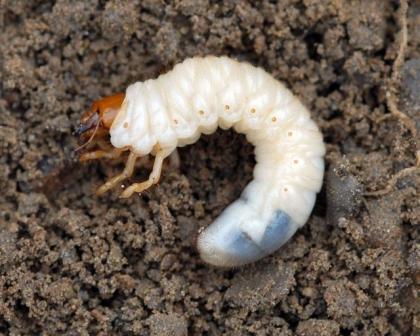It’s amazing how many things in life seem complex when we try to figure them out for ourselves but then we end up smacking ourselves on the forehead when someone shows us how simple it really is. The infield fly rule comes to mind. Some colleagues of mine here at Michigan State may be on their way to such a solution for the problem of white grubs in lawns. Drs. Dave Smitley (Entomology), Kurt Steinke, and Trey Rogers (Crop and Soil Science) are investigating the effect of mower height on turf damage from grubs.

European chafer grub. Photo: David Smitley
The premise is simple: White grubs damage turf when they consume about 75% of the turf roots present. Raising the mowing height of most standard mowers from 2” to the highest setting (usually 3 ½”) also results in more root growth; often by more than double. Since there’s a limit to how much root mass grubs can consume, increasing the amount of roots ensures the damage threshold is never reached. The working hypothesis has been confirmed by greenhouse tests and now the researchers are taking to the field.

Chafer grub damage. Photo: David Smitley
This may turn out to be another example of how raising mower height and not trying to make your lawn look like a golf course fairway can reduce inputs and keep your turf healthier.
I know squat about turf and less about grubs so this may be a silly question, but if there are more roots to eat, won’t the grub population swell the following year to match the available food?
This post transports me back to the 1970’s living near Newark, NY then the headquarters of Jackson & Perkins. No one noticed the grubs hiding in a shipment of roses from abroad and they were planted straight away into the trial fields. The following spring lawns within 5 miles were severly damaged. The next spring the devastation had spread to a 50 mile radius and from there it was unstopable, the chafer beetle winged its way over state lines, the grubs chewing on grass roots resulting in tons of chemicals needed to control the situation annually.
There does not appear to be any grub damage in areas where tall grasses grow undisturbed or on grass lots grown for hay. But, I am going to guess that the average lawn would have to be allowed to grow six inches in height, maybe more, to stop grub damage. Don’t think this would be acceptable to most homeowners or HOA’s or those living in tick country.
Always dangerous when you report on other people’s work. I think the idea is that grubs increase with the amount of roots up to a certain level, basically a ‘carrying capacity’, Beyond this point new root growth exceed what the grubs can consume. with regards to aethetics and acceptability; one of the PI’s (Rogers) is one of the leading experts in the world on turf and has worked with many major league sports teams and Olympic venues. I’m sure overall quality and acceptability will be in their accessment.
I think we also need to get bakc to Jeff’s earlie
r point. For some, a perfect fairway style, weed-free lawn will always be the goal. But I think a growing portion of the population in realizing this comes at an environmental cost.
Hi just adding my comment to see if there were any “latest” thoughts on this. I do agree in lengthening the turf for longer roots and practice longer turf in my own lawn, however my customers wont follow the same advice. Other than the stuff already out there (nematodes etc.) I was just more curious to hear if there were any more methods better suited to leatherjackets and chafer grub control. Here in the Uk we have zero chemical controls, however I personally am learning and leaning towards more natural methods, some of which Ive tried and need to try more. Thank you
The original blogger is no longer with the Garden Professors, but I’m posting your comment anyways. Perhaps we will get some other activity on it.